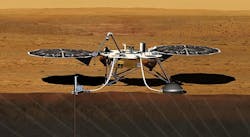NASA and the National Center for Space Studies of France (CNES) have signed an agreement for future cooperation on a NASA Mars lander. The Interior Exploration Using Seismic Investigations, Geodesy, and Heat Transport (InSight) mission is planned to launch in March 2016 and will land on Mars six months later. The goal is to study and understand the evolutionary formation of planets (including Earth) by examining Mars’ interior. The structure and composition of Mars’ interior will be determined by CNES’s Seismic Experiment for Interior Structure (SEIS) instrument measuring seismic waves traveling through the interior. The SEIS and Heat Flow and Physical Properties Package (HP3), provided by the German Space Agency (DLR), will be the two scientific instruments in the lander.
Insight aims to determine how a rocky body forms and evolves to a planet by studying all features of Mars’ core, mantle, and crust, including the rate heat escapes from its interior. Information about Martian tectonic activity and potential meteorite impacts will also be studied by SEIS, potentially providing knowledge about those processes on Earth. Mars is large enough to have undergone the early processes that shaped terrestrial bodies, but small enough to have evidence of those processes for the next four billion years—unlike Earth. The mission will be led by W. Bruce Banerdt of the Jet Propulsion Laboratory (JPL) at CIT. InSight will last 720 days once on Mars’ surface, with the first since return projected for October 2016 and concluding in September 2018.
Additionally, InSight will be used for the Rotation and Interior Structure Experiment (RISE), led by JPL, to provide accurate measurements of planetary rotation. The instrumentation will be carried by the Lockheed Martin Space Systems’ Phoenix Lander.
About the Author
Sarah Mangiola
Sarah Mangiola has written on many different topics within Penton's Design, Engineering, and Sourcing Group. Originally from California, she graduated from the University of California, Davis with a B.A. in political science.
